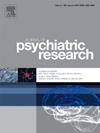Neurobehavioral characteristics and symptomatic correlations of audiovisual multisensory integration in schizophrenia: A systematic review and meta-analysis
IF 3.7
2区 医学
Q1 PSYCHIATRY
引用次数: 0
Abstract
Background
Multisensory integration (MSI) avoids cognitive overload, and the traditional all-or-nothing perspective for dysfunctional MSI in schizophrenia has been increasingly challenged. This study aimed to systematically review and meta-analyze extant evidence on audiovisual MSI in schizophrenia.
Methods
We searched Web of Science, PubMed, PsycINFO and PsycARTICLES databases from inception until April 16th, 2024. Studies using appropriate audiovisual integration tasks to compare either behavioral or neural responses between schizophrenia individuals and healthy controls were included. Primary outcome measures included between-group differences (Hedge's g) and symptomatic correlations (Fisher's z) in three components of audiovisual integration tasks, including audiovisual processing, adaptation and integration. The multilevel random-effects models were used to address statistical dependency.
Results
In total, 209 between-group and 116 correlational effect sizes were synthesized from 46 studies, representing 1108 non-overlapped schizophrenia participants and 1084 healthy controls. The overall dysfunctional audiovisual MSI in schizophrenia (g = −0.50, [95 % CI, −0.64 to −0.37]) was primarily ascribed to the impaired audiovisual processing (g = −0.53, [95 % CI, −0.71 to −0.35]) and adaptation (g = −0.71, [95 % CI, −0.99 to −0.42]), rather than integration itself (g = −0.23, [95 % CI, −0.56 to 0.11]). Pooled correlational effect size was extremely small (z = 0.16, [95 % CI, 0.03 to 0.30]).
Conclusions
Individuals with schizophrenia show dysfunctional multisensory processing and adaptation, but preserve a less impaired multisensory integration ability. Our findings provide implications for clinical interventions, as the relatively preserved audiovisual integration ability may serve as a possible avenue for cognitive training programs.
精神分裂症的视听多感觉整合的神经行为特征和症状相关性:系统回顾和荟萃分析
多感觉统合(MSI)避免了认知超载,传统的全有或全无的观点对精神分裂症功能失调的MSI越来越受到挑战。本研究旨在系统回顾和荟萃分析精神分裂症中视听MSI的现有证据。方法检索Web of Science、PubMed、PsycINFO和PsycARTICLES数据库,检索时间为成立之日至2024年4月16日。使用适当的视听整合任务来比较精神分裂症患者和健康对照组之间的行为或神经反应的研究包括在内。主要结果测量包括视听整合任务三个组成部分的组间差异(Hedge’s g)和症状相关性(Fisher’s z),包括视听处理、适应和整合。采用多水平随机效应模型来解决统计依赖性。结果从46项研究中共合成了209个组间效应量和116个相关效应量,分别代表了1108名非重叠精神分裂症患者和1084名健康对照。精神分裂症患者的整体视听MSI功能失调(g = - 0.50, [95% CI, - 0.64至- 0.37])主要归因于视听处理(g = - 0.53, [95% CI, - 0.71至- 0.35])和适应(g = - 0.71, [95% CI, - 0.99至- 0.42])受损,而不是整合本身(g = - 0.23, [95% CI, - 0.56至0.11])。合并相关效应值非常小(z = 0.16, [95% CI, 0.03 ~ 0.30])。结论精神分裂症患者存在多感觉加工和适应功能障碍,但多感觉整合能力受损程度较轻。我们的研究结果为临床干预提供了启示,因为相对保存的视听整合能力可能作为认知训练计划的可能途径。
本文章由计算机程序翻译,如有差异,请以英文原文为准。
求助全文
约1分钟内获得全文
求助全文
来源期刊

Journal of psychiatric research
医学-精神病学
CiteScore
7.30
自引率
2.10%
发文量
622
审稿时长
130 days
期刊介绍:
Founded in 1961 to report on the latest work in psychiatry and cognate disciplines, the Journal of Psychiatric Research is dedicated to innovative and timely studies of four important areas of research:
(1) clinical studies of all disciplines relating to psychiatric illness, as well as normal human behaviour, including biochemical, physiological, genetic, environmental, social, psychological and epidemiological factors;
(2) basic studies pertaining to psychiatry in such fields as neuropsychopharmacology, neuroendocrinology, electrophysiology, genetics, experimental psychology and epidemiology;
(3) the growing application of clinical laboratory techniques in psychiatry, including imagery and spectroscopy of the brain, molecular biology and computer sciences;
 求助内容:
求助内容: 应助结果提醒方式:
应助结果提醒方式:


